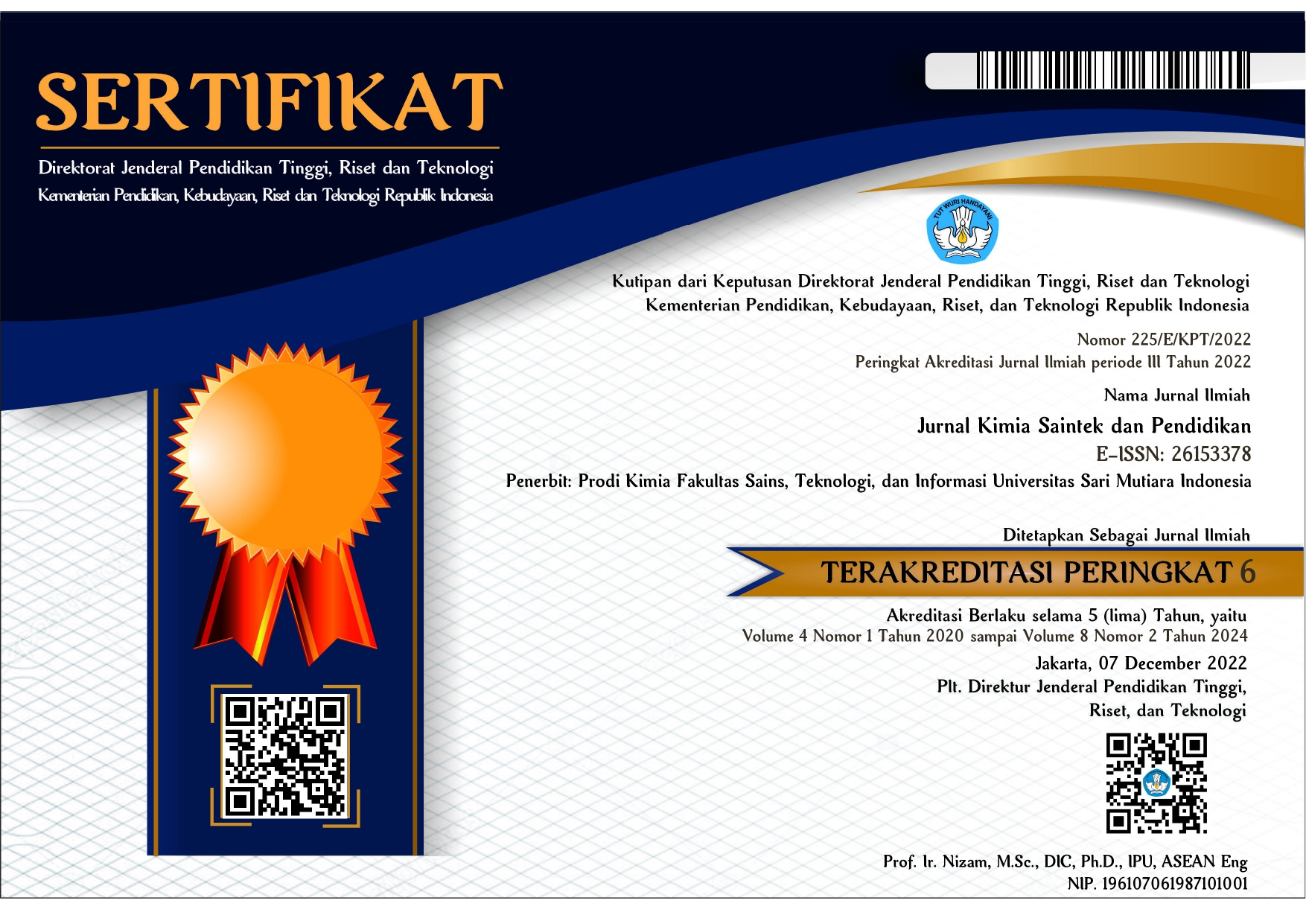CONDUCTIVITY ANALYSIS OF CU/N-GRAPHENE AND NI/N-GRAPHENE AS ELECTRODES ON PRIMARY BATTERY ANODES
DOI:
https://doi.org/10.51544/kimia.v8i1.5325Keywords:
conductivity, dopant, graphene, impregnation, N-grapheneAbstract
This study used a modified Hummer method to synthesize Graphene and nitrogen dopant to produce N-Graphene. Cu/N-Graphene and Ni/N-Graphene electrodes were each made using the impregnation method. Conductivity analysis of graphene, N-graphene, Cu/N-Graphene, and Ni/N-Graphene was carried out using a multimeter. The conductivity data of Cu/N-Graphene (83.16 µS/cm) and Ni/N-Graphene (85.67 µS/cm) produced were higher than commercial battery anodes (26 µS/cm). These data prove that N-graphene can improve the performance of Cu/N-Graphene and Ni/N-Graphene on primary battery anodes and can be used as an alternative anode on primary battery anodes.
Downloads
References
E. P. Randviir, D. A. C. Brownson, and C. E. Banks, “A decade of graphene research: Production, applications and outlook,” Nov. 01, 2014, Elsevier B.V. doi: 10.1016/j.mattod.2014.06.001.
R. Raccichini, A. Varzi, S. Passerini, and B. Scrosati, “The role of graphene for electrochemical energy storage,” Nat Mater, vol. 14, no. 3, pp. 271–279, 2015, doi: 10.1038/nmat4170.
A. Bianco et al., “All in the graphene family - A recommended nomenclature for two-dimensional carbon materials,” 2013, Elsevier Ltd. doi: 10.1016/j.carbon.2013.08.038.
H. Zhou et al., “A universal synthetic route to carbon nanotube/transition metal oxide nano-composites for lithium ion batteries and electrochemical capacitors,” Sci Rep, vol. 6, Nov. 2016, doi: 10.1038/srep37752.
Y. Xin et al., “Preparation and characterization of Pt supported on graphene with enhanced electrocatalytic activity in fuel cell,” J Power Sources, vol. 196, no. 3, pp. 1012–1018, Feb. 2011, doi: 10.1016/j.jpowsour.2010.08.051.
M. ; Supeno, C. ; Simanjuntak, R. * Siburian, and +•, “Facile and Benign Method to Produce Large Scale Graphene Nano Sheets,” 2020.
K. Bhowmik, A. Mukherjee, M. K. Mishra, and G. De, “Stable ni nanoparticle-reduced graphene oxide composites for the reduction of highly toxic aqueous Cr(VI) at room temperature,” Langmuir, vol. 30, no. 11, pp. 3209–3216, Mar. 2014, doi: 10.1021/la500156e.
X. Huang et al., “Graphene-based materials: Synthesis, characterization, properties, and applications,” Jul. 18, 2011. doi: 10.1002/smll.201002009.
L. Yang, W. Liu, H. Wang, S. Liu, J. Wang, and J. Chen, “A low-cost and one-step synthesis of a novel hierarchically porous Fe3O4/C composite with exceptional porosity and superior Li+ storage performance,” RSC Adv, vol. 5, no. 125, pp. 102993–102999, Nov. 2015, doi: 10.1039/c5ra24166a.
G. Witjaksono et al., “Effect of nitrogen doping on the optical bandgap and electrical conductivity of nitrogen-doped reduced graphene oxide,” Molecules, vol. 26, no. 21, Nov. 2021, doi: 10.3390/molecules26216424.
Ababay Ketema Worku and Delele Worku Ayele, “Recent advances of graphene-based materials for emerging technologies,” Jan. 01, 2023, Elsevier B.V. doi: 10.1016/j.rechem.2023.100971.
Downloads
Published
Issue
Section
License
Copyright (c) 2024 Crystina Simanjuntak, Rikson Siburian, Amanda Jiamin

This work is licensed under a Creative Commons Attribution-ShareAlike 4.0 International License.











.png)

